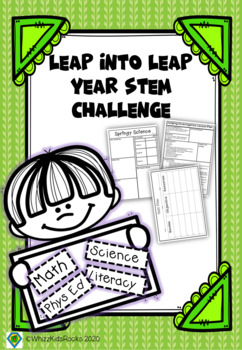Leap Year STEM Challenge
- PDF
Also included in
- STEM activities provide the perfect opportunity for hands-on collaborative work. Students think critically and creatively and build on their mistakes to move their learning forward. A STEM experience is a perfect place to learn to “Try, Try Again!This bundle contains all three of my Challenge resourPrice $10.80Original Price $12.00Save $1.20
Description
The Leap Year STEM Challenge is a huge hit with my students. Their eyes light up when they see a STEM challenge on our agenda and your students will too! There is just something special about planning and building your own work and testing it to. It is so much fun to watch the concentration on their faces as they work out what they want to do and how they are going to do it, and their joy when they succeed. This challenge is one you must try!
STEM activities provide the perfect opportunity for hands-on collaborative work. Students think critically and creatively and build on their mistakes to move their learning forward. A STEM experience is a perfect place to learn to “Try, Try Again!
This STEM challenge is divided into two parts - a measuring and jumping activity and a design activity. Both activities have cross-curricular links with Maths, Literacy, Science, PE, IT and Design Technology, and draw on a range of skills including teamwork, leadership, prediction, inference, drawing conclusions, presentation of information etc.
Students begin with the jumping challenge, where they predict whether height makes a difference to the distance jumped, measure each other, plan their jump, carry out their tests and record the outcomes. Planning sheets, record sheets and graphs are provided.
The second part of the challenge sees the students finding out how a grasshopper can jump such great distances, and applying the science to their own design. Finally, they present their outcomes to the class, with fellow students peer assessing their work.
Students an use any materials they like - it is their design and part of the challenge is evaluating the brief and discussing, planning and delivering outcomes.
Contents:
- Cover Sheet
- Introduction
- Unit plan
- Lesson plans
- KWL chart
- Challenge task cards
- Task planning sheets
- Task record sheets
- Predictions sheets (differentiated)
- Graphing activity
- Conclusions sheets (differentiated)
- Grasshopper fact sheets
- data planning sheet
- Design planning sheet
- Blank poster
- Assessment rubric
- Terms of Use page
This resource is suitable for US, UK, Australian and Canadian audiences. Why not organise a week of activities to mark leap year with my Big Idea Challenge Relay Scoot - Leap Year and Leap Year Close Reading Comprehension
This is a SUPER activity and one your students will ask to be repeated! Don't leave it on the shelf until next leap year - use it regularly.






